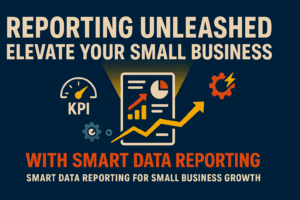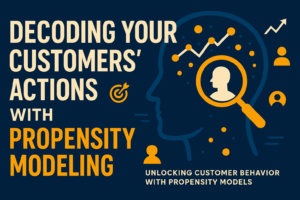As an American-made manufacturer, you've relentlessly optimized your production line, yet three hidden wastage points beyond your view still threaten your profitability and even your business survival.
Read MoreBusiness Analytics Report: Elevating Small Business Success
In small business operations, gathering, interpreting, and acting upon data is paramount. However, many entrepreneurs find themselves trapped in the bottlenecks of manual data compilation, a process that is not only time-intensive but fraught with risks. Traditional reporting methods often mean poring over spreadsheets for hours, which can lead to human error and limit the potential insights gleaned from the data.
As the landscape of business analytics and reporting evolves, it becomes increasingly clear that manual data handling is a limitation that modern businesses cannot afford. The risks associated with this antiquated approach are manyfold, including the potential for inaccuracies, data breaches, and the inevitable delay in decision-making due to the slow pace of report generation.
Challenges of Conventional Reporting Techniques
- The meticulous and often repetitive tasks involved in traditional reporting can consume valuable time better spent on strategic planning or other high-value activities.
- Manual data handling is susceptible to human error, which can lead to flawed business insights and misguided strategies.
By understanding these limitations, businesses are better positioned to appreciate the benefits of transitioning to more advanced analytics and reporting methods, such as those provided by automated systems and tailored analytical report templates.
Embracing Automation for Enhanced Reporting Efficiency
Automation has become a cornerstone in the evolution of business analytics and reporting. By integrating automated reporting systems, businesses can significantly reduce the time and effort spent on data collection and report generation. These systems are designed to automate repetitive tasks, such as data aggregation and visualization, which not only accelerates the reporting process but also minimizes the potential for human error.
The functionality of these systems often includes advanced data analytics capabilities, allowing for on-time insights and the ability to quickly adapt to new data. This means that businesses can respond more rapidly to market changes, customer behavior, and internal performance metrics. The use of an analysis report template simplifies the process, providing a consistent and professional format that can be customized to meet the specific needs of the organization.
By leveraging analysis report templates, companies can ensure that their reports maintain a high standard of clarity and comprehensibility. This is crucial when sharing insights across different departments or with stakeholders who may not have a background in data analysis. Ultimately, the shift towards automation in business analytics report creation fosters a more efficient, accurate, and strategic approach to data-driven decision-making.
How often should KPIs be reviewed for business growth?
The role of personalized reports in strategic business planning cannot be overstated. Customized business analytics reports offer a tailored view of data that aligns with the unique objectives and challenges of a business. By leveraging a business analysis report example, companies can understand how to effectively dissect and interpret their data, leading to more informed decision-making.
Features and benefits of bespoke analytical report templates include the ability to highlight key performance indicators that matter most to the business, integrate various data sources for a comprehensive overview, and present findings in an accessible format for stakeholders. The customization aspect ensures that the report is not just a collection of numbers but a narrative that resonates with the business’s goals and aids in carving out a competitive edge.
Real-World Success: Automation's Role in Business Expansion
Business analytics reports are not just theoretical tools; they have real-world implications that can lead to significant business growth. By examining our case studies where companies have implemented report automation, we see a clear pattern of positive outcomes. These businesses often experience a surge in efficiency, allowing them to allocate resources more effectively and focus on expansion strategies.
For example, a small e-commerce retailer might use a dashboard to track customer behavior and inventory levels. Post-automation, the retailer could see a reduction in overstock and an uptick in customer satisfaction due to more personalized marketing efforts. Such tangible results underscore the value of transitioning from manual processes to automated business analytics and reporting systems.
Metrics That Matter: Evaluating Growth
- Revenue Growth: Companies often report a noticeable increase in revenue following the adoption of automated reporting, thanks to data-driven decision-making.
- Cost Reduction: Automation reduces the need for manual labor, leading to cost savings in personnel and error mitigation.
- Time Savings: Automated business analytics reports cut down on the time needed for data compilation, freeing up time for strategic tasks.
- Customer Satisfaction: With improved data insights, businesses can tailor their offerings to meet customer needs more effectively, leading to higher satisfaction rates.
By leveraging business analysis report examples and customizable analysis report templates, companies not only streamline their operations but also pave the way for scalable growth. The transition to automated systems is a stepping stone to a more data-driven and successful business model.
Voices from the Field: Client Perspectives on Analytical Transformation
When it comes to understanding the real-world impact of business analytics and reporting, there’s no substitute for hearing directly from those who have experienced the transformation. A business analytics report serves as a crucial tool in decision-making, and clients often express how these reports have revolutionized their operations. For instance, one client noted that by utilizing an analytics reporting, they were able to cut down the time spent on data analysis by half, allowing them to focus more on strategic initiatives.
Another client shared their story, revealing how a comprehensive business analysis report provided by their analytics partner helped them to identify previously unnoticed market trends, leading to a pivot in their business strategy that significantly increased their market share. These personal accounts underscore the value of tailored analytics solutions in driving efficiency and uncovering actionable insights.
Moreover, the feedback consistently highlights the benefits of time and resource savings. A particularly compelling testimony came from a small business owner who was able to reallocate staff to higher-value tasks after automating their reporting processes with Catalyst. This not only boosted staff morale but also resulted in more innovative projects being developed. Such testimonials serve as powerful endorsements for the adoption of business analytics and reporting solutions. Below is a summary of one of our case studies that show the power of automated analytics reports.
XstremeMD (XMD), a leading medical services provider, faced the challenge of manually generating internal encounter reports and external return on investment reports for customers. CDA took on the task of recreating XMD’s reports within the Tableau platform while incorporating best-in-class data visualizations for better analysis. To support the reporting infrastructure, an RDS database was utilized, providing a reliable and scalable solution for data storage and retrieval. Automation of reports that eliminated $6,000 worth of manual effort per year. The data being available on time allowed the staff to gain insights worth an additional $114,000 for the year.
Answering Your Queries: Unveiling the Power of Business Analytics
When it comes to business analytics reports, many professionals have questions about their significance and how they can revolutionize data-driven decision-making. A well-crafted business analysis report is more than just a document; it’s a roadmap that guides companies through complex data landscapes, offering insights that drive strategic initiatives.
For instance, a business analysis report might illustrate how integrating analysis reports can save time and improve accuracy. These reports provide a standardized approach to data analysis, ensuring that all relevant information is considered and presented in a clear, concise manner. Moreover, the use of analytical report templates in business analytics and reporting not only streamlines the process but also empowers businesses to uncover trends and patterns that may otherwise go unnoticed.
The journey towards advanced analytics and reporting doesn’t have to be daunting. With the right tools and guidance, small businesses can harness the power of data to drive strategic decision-making and growth. The first step is to embrace automation, which not only streamlines the process but also mitigates the risks associated with manual data handling. By leveraging customized business analytics reports, businesses can gain valuable insights tailored to their unique needs. The future of business lies in data-driven decision-making, and Capitol Data Analytics is committed to empowering businesses to take that leap.
Related Articles We Think You Would Enjoy Next
Reporting Unleashed: Elevate Your Small Business with SMART Data Reporting
Reporting is often the most overlooked piece of data analytics. Reporting is the key cog in the data analytics.
Read MoreDecoding Your Customers’ Actions With Propensity Modeling
Propensity models are a group of statistical models that provide immense value to your organization.
Read More

